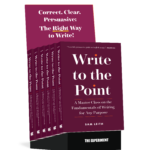At Ithaca College in upstate New York, every first year student is required to take a freshman writing seminar. If memory serves, there are no exceptions made. Most students bemoaned this requirement; the writing seminars were either too early in the morning, required too much, uh, writing, or were deemed downright unnecessary for a high school graduate. I was among those who didn’t particularly think they needed a freshman writing seminar–I had taken AP English, after all. The first paper I turned in for the class came back covered in red ink. Half of what I had written was crossed off and “????” appeared frequently in the margins. As someone planning to major in writing, to say I was chagrined would be an understatement.
Most of us in college were not going to major in writing and most people in this country don’t write for a living. Therefore, most people don’t think they need writing instruction. Except that, most of us walk around with a keyboard in our pants pocket.
“Writing instruction” sounds very formal; it sounds like grammar exercises and lessons in punctuation. And it is that. But, as Sam Leith makes clear in his new book, Write to the Point: A Master Class on the Fundamentals of Writing for Any Purpose, writing well is about much more than mastering the nuts and bolts. He says:
 “Writing is a representation of speech, not a transcription of it. You’re translating something that lives in sound into something that lives on the page…That is a more radical transformation than we’re used to noticing. When you’re writing, you’re trying to produce the illusion of your best speaking voice, in the most apt register, in written form.”
“Writing is a representation of speech, not a transcription of it. You’re translating something that lives in sound into something that lives on the page…That is a more radical transformation than we’re used to noticing. When you’re writing, you’re trying to produce the illusion of your best speaking voice, in the most apt register, in written form.”
We all write; we make choices about how best to convey a message through written word every day, throughout the day. Look at the last three text messages you wrote. The punctuation, the emojis, the tone, the vernacular are all tailored for the person to whom the text was sent. You write your mom differently than you write your boss than you write the person you’re trying to take on a date. Everytime you write, Leith point out, “you are trying to make a connection with your audience.” Learning how best to write for your intended audience is key if we hope to be trusted, warmed to, believed.
Let’s keep looking at the texts we send. In addition to tailoring our tone, our “register” for a specific audience, we also use emojis, exclamation points, etc, because more than anything, we fear being misunderstood over text. As Leith points out, “One of the sociological features of standard English is that many of its users place a high value on getting it right.”
How often have you written and sent a text message only to wish it back a second, an hour, a month later?
“Fear,” Leith writes, “…is what makes people sound stiff and pompous in print, and fear is what makes people cling to half-remembered rules from their school days.” Imagine the way texting someone you’re trying to date differs from the way you text your best friend. Fear makes us overthink, makes us focus on our word choice or our punctuation and not on what we are actually trying to convey. “Writing,” Leith says, “is in some ways a confidence trick.”
Leith covers much more than just texting in Write to the Point, but what make his book so special is his recognition that good writing is about more than correct grammar and following a set of rules. Learning to write for an intended audience and learning to write without fear are just two of the many important lessons Leith covers. In a digital age, we all rely on writing to help us be understood by all variety of audiences. Leith understands this modern need and has written the book to address it–even for those who don’t think they need it.
For more writing know-how, check out Write to the Point. Available on August 7 wherever books are sold.


